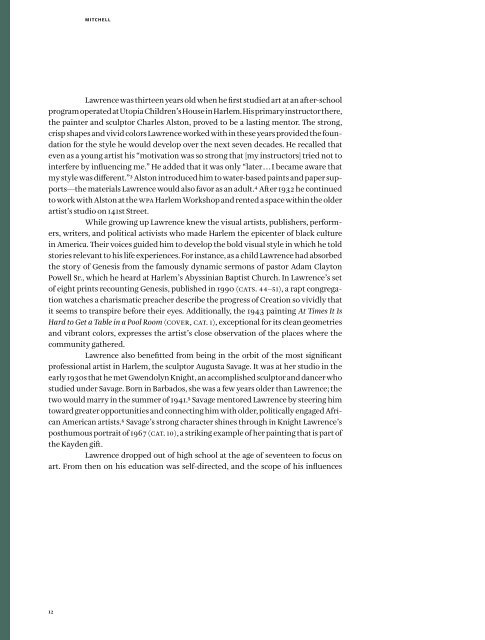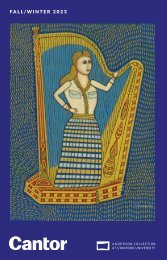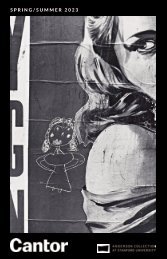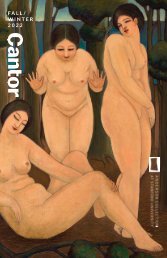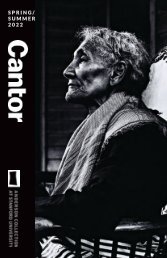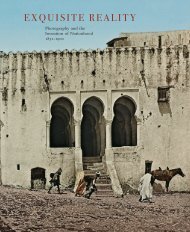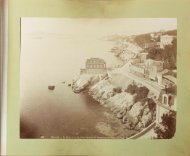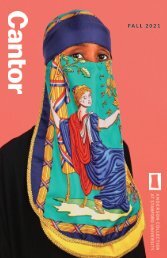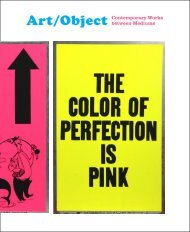Exhibition Catalog | Jacob Lawrence
Explore a gift of drawings, prints, and paintings by African American modernist Jacob Lawrence addressing Black history and civil rights, public life, faith, and creativity.
Explore a gift of drawings, prints, and paintings by African American modernist Jacob Lawrence addressing Black history and civil rights, public life, faith, and creativity.
Create successful ePaper yourself
Turn your PDF publications into a flip-book with our unique Google optimized e-Paper software.
MITCHELL<br />
<strong>Lawrence</strong> was thirteen years old when he first studied art at an after-school<br />
program operated at Utopia Children’s House in Harlem. His primary instructor there,<br />
the painter and sculptor Charles Alston, proved to be a lasting mentor. The strong,<br />
crisp shapes and vivid colors <strong>Lawrence</strong> worked with in these years provided the foundation<br />
for the style he would develop over the next seven decades. He recalled that<br />
even as a young artist his “motivation was so strong that [my instructors] tried not to<br />
interfere by influencing me.” He added that it was only “later . . . I became aware that<br />
my style was different.”³ Alston introduced him to water-based paints and paper supports—the<br />
materials <strong>Lawrence</strong> would also favor as an adult.⁴ After 1932 he continued<br />
to work with Alston at the wpa Harlem Workshop and rented a space within the older<br />
artist’s studio on 141st Street.<br />
While growing up <strong>Lawrence</strong> knew the visual artists, publishers, performers,<br />
writers, and political activists who made Harlem the epicenter of black culture<br />
in America. Their voices guided him to develop the bold visual style in which he told<br />
stories relevant to his life experiences. For instance, as a child <strong>Lawrence</strong> had absorbed<br />
the story of Genesis from the famously dynamic sermons of pastor Adam Clayton<br />
Powell Sr., which he heard at Harlem’s Abyssinian Baptist Church. In <strong>Lawrence</strong>’s set<br />
of eight prints recounting Genesis, published in 1990 (cats. 44–51), a rapt congregation<br />
watches a charismatic preacher describe the progress of Creation so vividly that<br />
it seems to transpire before their eyes. Additionally, the 1943 painting At Times It Is<br />
Hard to Get a Table in a Pool Room (cover, cat. 1), exceptional for its clean geometries<br />
and vibrant colors, expresses the artist’s close observation of the places where the<br />
community gathered.<br />
<strong>Lawrence</strong> also benefitted from being in the orbit of the most significant<br />
professional artist in Harlem, the sculptor Augusta Savage. It was at her studio in the<br />
early 1930s that he met Gwendolyn Knight, an accomplished sculptor and dancer who<br />
studied under Savage. Born in Barbados, she was a few years older than <strong>Lawrence</strong>; the<br />
two would marry in the summer of 1941.⁵ Savage mentored <strong>Lawrence</strong> by steering him<br />
toward greater opportunities and connecting him with older, politically engaged African<br />
American artists.⁶ Savage’s strong character shines through in Knight <strong>Lawrence</strong>’s<br />
posthumous portrait of 1967 (cat. 10), a striking example of her painting that is part of<br />
the Kayden gift.<br />
<strong>Lawrence</strong> dropped out of high school at the age of seventeen to focus on<br />
art. From then on his education was self-directed, and the scope of his influences<br />
12


